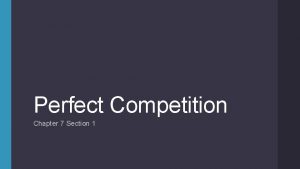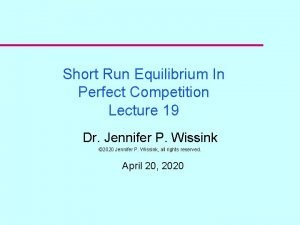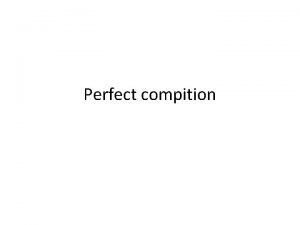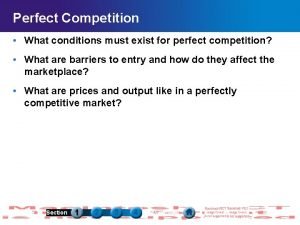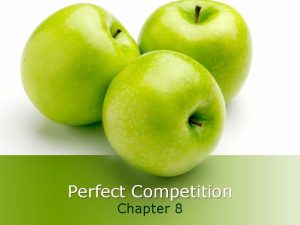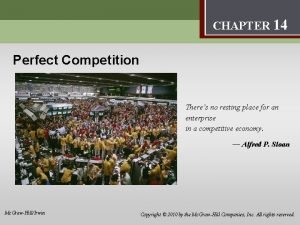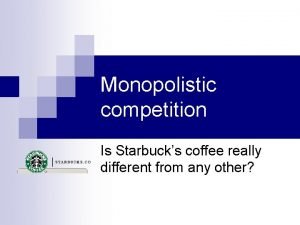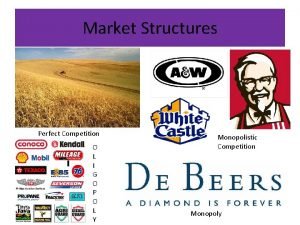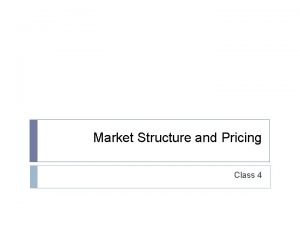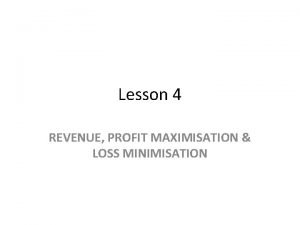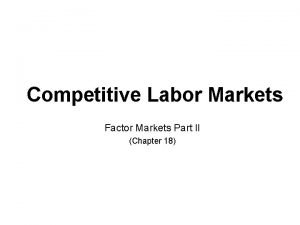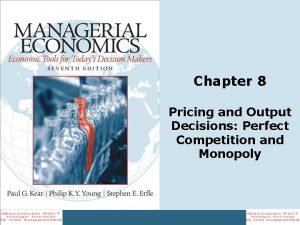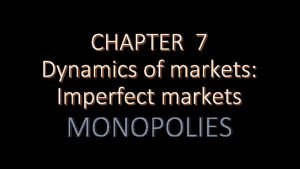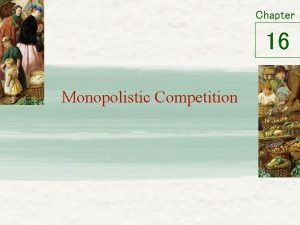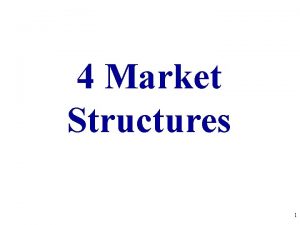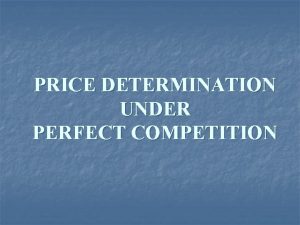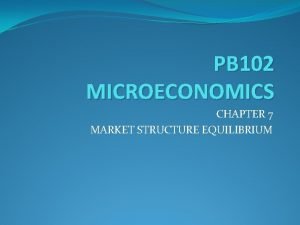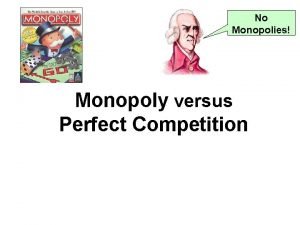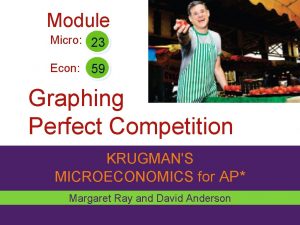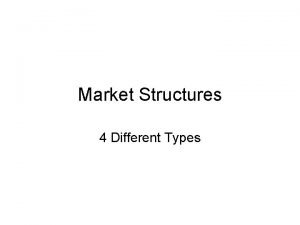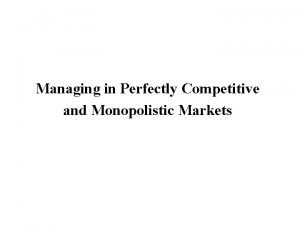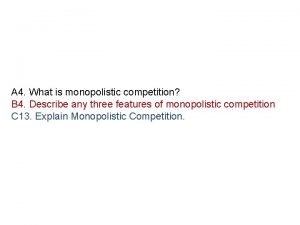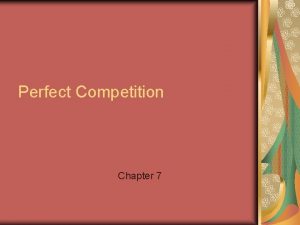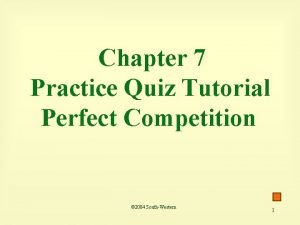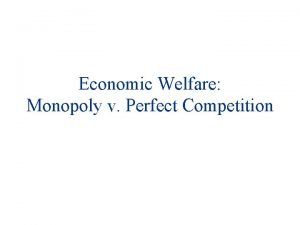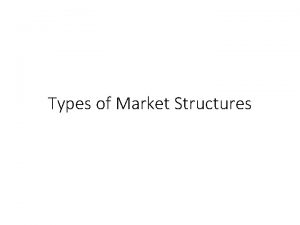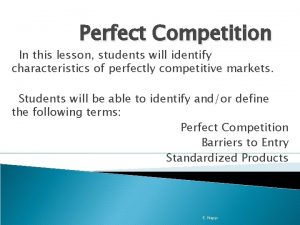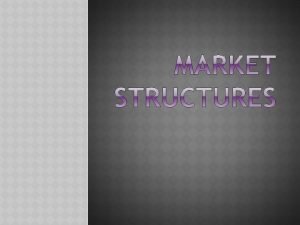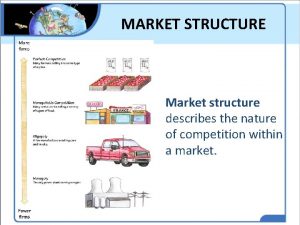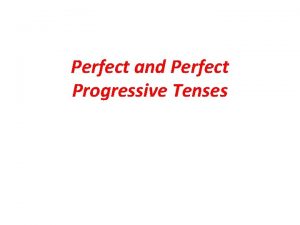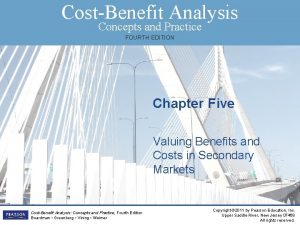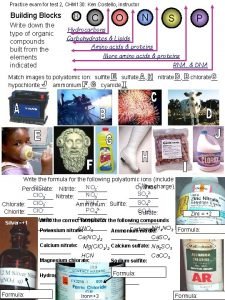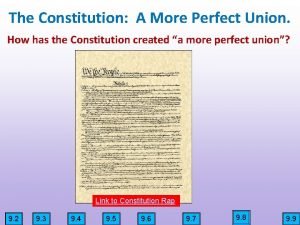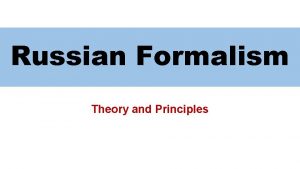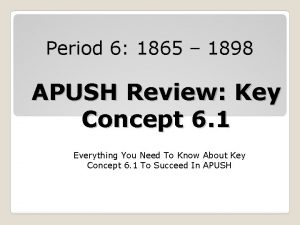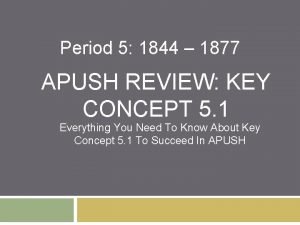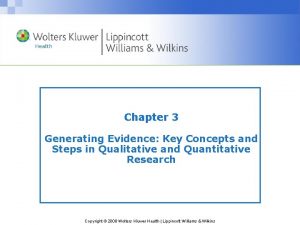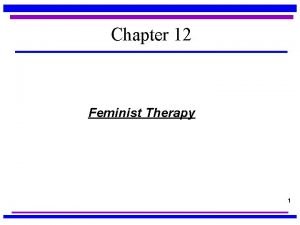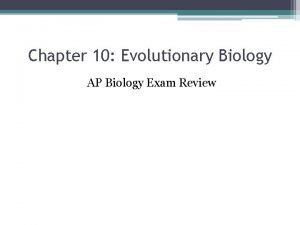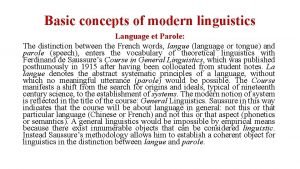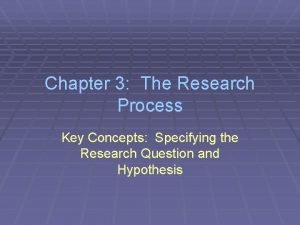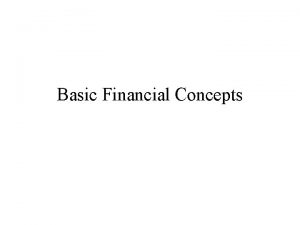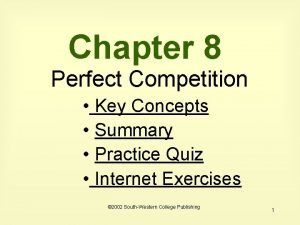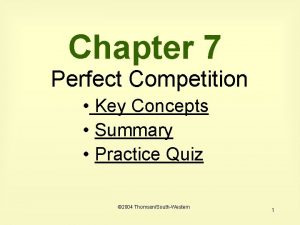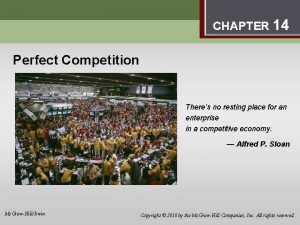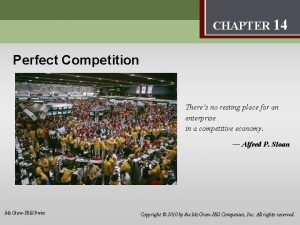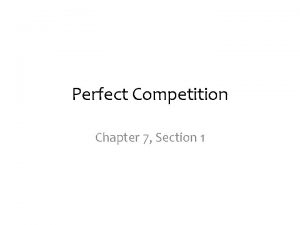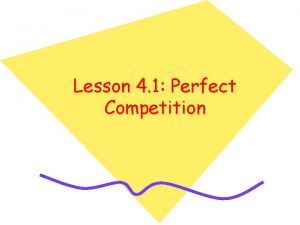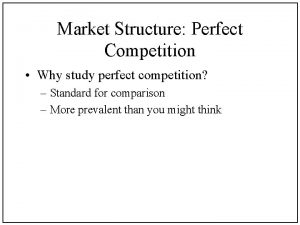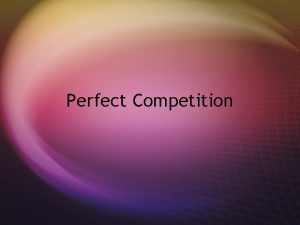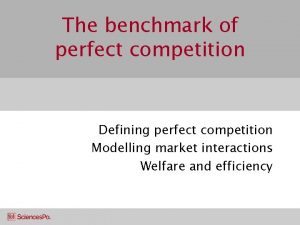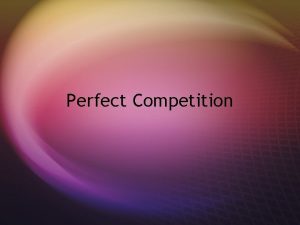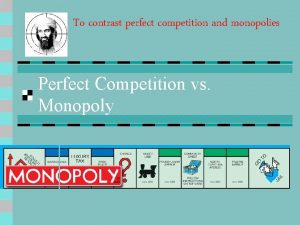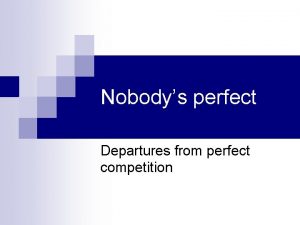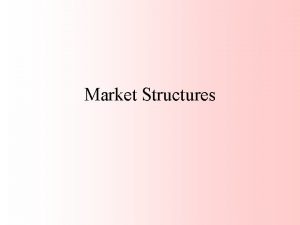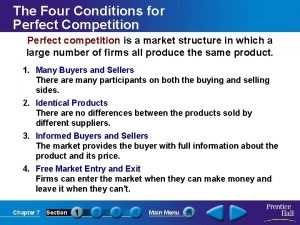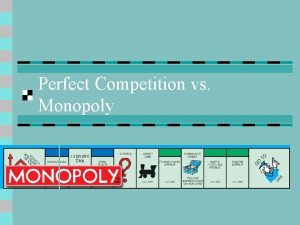Chapter 8 Perfect Competition Key Concepts Summary Practice










































































- Slides: 74

Chapter 8 Perfect Competition • Key Concepts • Summary • Practice Quiz • Internet Exercises © 2002 South-Western College Publishing 1

Who was Adam Smith? The father of modern economics who wrote The Wealth of Nations, published in 1776 2

What did Adam Smith say about competitive forces? They are like an “invisible hand” that leads people who simply pursue their own interests to serve the interests of society 3

What is the purpose of this chapter? To explain how competitive markets determine prices, output, and profits 4

What is market structure? A classification system for the key traits of a market, including the number of firms, the similarity of the products they sell, and the ease of entry and exit 5

What is perfect competition? 1. many small firms 2. homogeneous product 3. very easy entry and exit 4. price taker 6

What does homogeneous mean? Goods that cannot be distinguished from one another; for example, one potato cannot be distinguished from another potato 7

What is a price taker? A seller that has no control over the price of the product it sells 8

What determines price? Supply and Demand 9

P Market Supply and Demand $140 $130 $120 $100 $80 $60 $40 $20 S DQ 5 10 15 20 25 30 35 40 45 10

What determines the individual firm’s demand curve? A horizontal line at the market price 11

$140 $130 $120 Individual firm demand $100 $80 $60 $40 $20 5 10 15 20 25 30 35 40 45 D 12

Why is this horizontal line the firm’s demand curve? If the firm charges more than this price, it will not sell anything, and it has no incentive to charge less than this price 13

Why does the firm have no incentive to charge less than the market price? It can sell everything it brings to market at the market price 14

What does the perfectly competitive firm control? The only thing it controls is how many units it produces 15

How many units should this firm produce? The number of units whereby it will maximize its profits, or at least minimize its losses 16

What are the two methods to determine how many units to produce? • TR and TC • MR and MC 17

Using the total revenue - total cost method, where should a firm produce? Where the distance between TR and TC is the greatest 18

P $500 Maximize Profit TR $400 TC $300 $200 $100 Quantity of Output 1 2 3 4 5 Q 19

P Maximize Profit Output $150 $100 TR $50 0 -$50 Quantity of Output 1 2 3 4 5 Q 20

What is marginal revenue? MR = TR / 1 output 21

What is marginal cost? MC = TC / 1 output 22

Using the marginal revenue and marginal cost method, where should a firm produce? MR = MC 23

Why should a firm continue to produce as long as MR > MC? As long as MR is > than MC, money is being made on that last unit 24

Why will a firm not produce that unit where MR < MC? At the unit of output where MR < MC, money is being lost on that last unit 25

Why does P = AR in perfect competition? Each additional unit sold is adding the market price to TR and TR divided by P = AR 26

Price & Cost per unit $80 $70 $60 $50 $40 $30 $20 $10 MR=MC MC ATC P = MR = AR Profit AVC 1 2 3 4 5 6 7 8 9 27

$70 $60 $50 $40 $30 $20 $10 Price & Cost per unit P MR=MC MC Loss ATC AVC P=MR=AR 1 2 3 4 5 6 7 8 9 Q 28

$70 $60 $50 $40 $30 $20 $10 Price & Cost per unit P Short-Run Shutdown MC ATC AVC Loss P=MR=AR MR=MC 1 2 3 4 5 6 7 8 9 Q 29

Firm will shut down Price (MR) is below minimum average variable cost 30

What is the perfectly competitive firm’s shortrun supply curve? The firm’s marginal cost curve above the minimum point on its average variable cost curve 31

P $70 $60 $50 $40 $30 $20 $10 Firm’s Short-Run Supply Curve MR 3 MR 2 MC ATC AVC MR 1 1 2 3 4 5 6 7 8 9 Q 32

What is the industry’s supply curve? The summation of the individual firm’s MC curves that lie above their minimum AVC points 33

P $130 $120 $100 $80 $60 $40 $20 Industry Equilibrium S = MC 5 10 15 20 25 30 35 40 45 Q 34

What is a normal profit? The minimum profit necessary to keep a firm in operation 35

In the long-run, what happens when economic profits are made? When firms make more than a normal profit, firms enter the industry, as supply increases, a downward pressure is put on prices 36

In the long-run, what happens when losses are made? When firms make less than a normal profit, firms leave the industry, as supply decreases, an upward pressure is put on prices 37

In the long-run, where is equilibrium? At the market price that enables firms to make a normal profit 38

What exists at long-run perfectly competitive equilibrium? P = MR = SRMC = SRATC = LRAC 39

P $70 $60 $50 $40 $30 $20 $10 Long-Run Competitive Equilibrium SRMC SATC LRAC MR 1 2 3 4 5 6 7 8 9 Q 40

P $130 $120 $100 $80 $60 $40 $20 Industry Equilibrium S = MC D 5 10 15 20 25 30 35 40 45 Q 41

What different types of industries can exist in the long-run? • Constant-cost • Decreasing-cost • Increasing-cost 42

What is a constant-cost industry? An industry in which the expansion of industry output by the entry of new firms has no effect on the firm’s cost curves 43

What does the longrun supply curve look like in a constant-cost industry? It is perfectly elastic, which is horizontal 44

Increase in demand sets a higher equilibrium price Entry of new firms increases supply Initial equilibrium price is restored Perfectly elastic long-run supply curve 45

What is a decreasingcost industry? An industry in which the expansion of industry output by the entry of new firms decreases the firm’s cost curves 46

What does the long-run supply curve look like in a decreasing-cost industry? It is downward sloping 47

Increase in demand sets a higher equilibrium price Entry of new firms increases supply Equilibrium price and ATC decrease Downward sloping long-run supply curve 48

What is an increasingcost industry? An industry in which the expansion of industry output by the entry of new firms increases the firm’s cost curves 49

What does the long-run supply curve look like in a increasing-cost industry? It is upward sloping 50

Increase in demand sets a higher equilibrium price Entry of new firms increases supply Equilibrium price and ATC increase Upward sloping long-run supply curve 51

Key Concepts 52

Key Concepts • • What is perfect competition? What is a price taker? What determines price? What determines the individual firm’s demand curve? • Why does the firm have no incentive to charge less than the market price? • Using the marginal revenue and marginal cost method, where should a firm produce? 53

Key Concepts cont. • Why does MR = P in perfect competition? • What is a normal profit? • In the long-run, what happens when economic profits are made? • In the long-run, what happens when losses are made? • In the long-run, where is equilibrium? • What different types of industries can exist in the long-run? 54

Summary 55

Market structure consists of three market characteristics: (1) the number of sellers, (2) the nature of the product, (3) the case of entry into or exit from the market. 56

Perfect competition is a market structure in which an individual firm cannot affect the price of the product it produces. Each firm in the industry is very small relative to the market as a whole, all the firms sell a homogeneous product, and firms are free to enter and exit the industry. 57

A price-taker firm in perfect competition faces a perfectly elastic demand curve. It can sell all it wishes at the marketdetermined price, but it will sell nothing above the given market price. This is because so many competitive firms are willing to sell at the going market price. 58

The total revenue-total cost method is one way the firm determines the level of output that maximizes profit. Profit reaches a maximum when the vertical difference between the total revenue and the total cost curves is at a maximum. 59

P $500 Maximize Profit TR $400 TC $300 $200 $100 Quantity of Output 1 2 3 4 5 Q 60

The marginal revenue equals marginal cost method is a second approach to finding where a firm maximizes profits. Marginal revenue is the change in total revenue from a one-unit change in output. Marginal revenue for a perfectly competitive firm equals the market price. 61

The MR = MC rule states that the firm maximizes profit or minimizes loss by producing the output where marginal revenue equals marginal cost. If the price (average revenue) is below the minimum point on the average variable cost curve, the MR = MC rule does not apply, and the firm shuts down to minimize its losses. 62

Price & Cost per unit $80 $70 $60 $50 $40 $30 $20 $10 MR=MC MC ATC P = MR = AR Profit AVC 1 2 3 4 5 6 7 8 9 63

$70 $60 $50 $40 $30 $20 $10 Price & Cost per unit P MR=MC MC Loss ATC AVC P=MR=AR 1 2 3 4 5 6 7 8 9 Q 64

$70 $60 $50 $40 $30 $20 $10 Price & Cost per unit P Short-Run Shutdown MC ATC AVC Loss P=MR=AR MR=MC 1 2 3 4 5 6 7 8 9 Q 65

The perfectly competitive firm’s short -run supply curve is a curve showing the relationship between the price of a product and the quantity supplied in the short run. 66

The individual firm always produces along its marginal cost curve above its intersection with the average variable cost curve. The perfectly competitive industry’s short-run supply curve is the horizontal summation of the short-run supply curves of all firms in the industry. 67

P $130 $120 $100 $80 $60 $40 $20 Industry Equilibrium S = MC 5 10 15 20 25 30 35 40 45 Q 68

Long-run perfectly competitive equilibrium occurs when the firm earns a normal profit by producing where price equals minimum long-run average cost equals minimum short-run average total cost equals shortrun marginal cost. 69

Long-Run Competitive Equilibrium P $70 $60 $50 $40 $30 $20 $10 Equilibrium SRMC SATC LRAC MR 1 2 3 4 5 6 7 8 9 Q 70

A constant-cost industry is an industry whose total output can be expanded without an increase in the firm’s average total cost. Because input prices remain constant, the long-run supply curve in a constant-cost industry is perfectly elastic. 71

A decreasing-cost industry is an industry in which lower input prices result in a downwardsloping long-run supply curve. As industry output expands, the firm’s average total cost curve shifts downward, and the long-run equilibrium market price falls. 72

An increasing-cost industry is an industry in which input prices rise as industry output increases. As a result, the firm’s average total cost curve rises, and the long-run supply curve for an increasingcost industry is upward sloping. 73

END 74
 Lump sum subsidy monopoly
Lump sum subsidy monopoly Monopoly vs monopolistic competition
Monopoly vs monopolistic competition Competition refers to
Competition refers to Market structure venn diagram
Market structure venn diagram Chapter 7 section 1 perfect competition worksheet answers
Chapter 7 section 1 perfect competition worksheet answers Perfect present
Perfect present Chapter 17 promotional concepts and strategies answer key
Chapter 17 promotional concepts and strategies answer key Perfect competition side by side graphs
Perfect competition side by side graphs Long run perfect competition equilibrium
Long run perfect competition equilibrium What is a short run supply curve
What is a short run supply curve Shut down point
Shut down point Barriers to entry for perfect competition
Barriers to entry for perfect competition Long run market supply curve
Long run market supply curve Perfect competition disadvantages
Perfect competition disadvantages Many buyers and sellers
Many buyers and sellers Perfect competition graph
Perfect competition graph Why is starbucks a monopolistic competition
Why is starbucks a monopolistic competition Monopoly and oligopoly examples
Monopoly and oligopoly examples Example of pure competition
Example of pure competition Barriers to entry for perfect competition
Barriers to entry for perfect competition Revenue maximisation point
Revenue maximisation point Factor market perfect competition
Factor market perfect competition Pricing and output decisions in perfect competition
Pricing and output decisions in perfect competition Market structure dominated by a few large profitable firms
Market structure dominated by a few large profitable firms Difference between monopoly and perfect competition
Difference between monopoly and perfect competition Perfect competition short run and long run
Perfect competition short run and long run Difference between perfect competition and monopoly
Difference between perfect competition and monopoly Three characteristics of perfect competition
Three characteristics of perfect competition Price determination under perfect competition
Price determination under perfect competition Short run equilibrium under perfect competition
Short run equilibrium under perfect competition Supernormal profit in perfect competition
Supernormal profit in perfect competition P = mc
P = mc Graphing perfect competition
Graphing perfect competition Difference between perfect competition and monopoly
Difference between perfect competition and monopoly Perfect/pure competition definition
Perfect/pure competition definition Consumer surplus in perfect competition
Consumer surplus in perfect competition Supernormal profit in perfect competition
Supernormal profit in perfect competition Perfect competition poster
Perfect competition poster Perfect competition quiz
Perfect competition quiz Is there deadweight loss in a monopoly
Is there deadweight loss in a monopoly The opposite of perfect competition is
The opposite of perfect competition is List the four conditions for perfect competition.
List the four conditions for perfect competition. A market dominated by a single seller
A market dominated by a single seller Market structure
Market structure Perfect pitch challenge
Perfect pitch challenge Disadvantages of perfect competition
Disadvantages of perfect competition Market structure
Market structure Key partners business model canvas
Key partners business model canvas Contoh bisnis model canvas makanan pdf
Contoh bisnis model canvas makanan pdf Perfect and perfect progressive tenses
Perfect and perfect progressive tenses Chapter 3 perfect and perfect progressive tenses
Chapter 3 perfect and perfect progressive tenses The key part of martens' definition of competition is
The key part of martens' definition of competition is Professional nursing practice 7th edition
Professional nursing practice 7th edition Professional nursing practice concepts and perspectives
Professional nursing practice concepts and perspectives Cost-benefit analysis concepts and practice
Cost-benefit analysis concepts and practice Chm 130 chapter 12 practice problems answer key
Chm 130 chapter 12 practice problems answer key Chapter 10 chemical quantities practice problems answer key
Chapter 10 chemical quantities practice problems answer key Chapter 7 a more perfect union answer key
Chapter 7 a more perfect union answer key Key concepts of russian formalism
Key concepts of russian formalism Key concepts examples
Key concepts examples Period 6 apush key concepts
Period 6 apush key concepts Compromise of 1877 apush
Compromise of 1877 apush Apush review.com
Apush review.com Apush key concepts period 2
Apush key concepts period 2 Key concepts in qualitative research
Key concepts in qualitative research Feminist therapy key concepts
Feminist therapy key concepts Reviewing key concepts reproductive barriers
Reviewing key concepts reproductive barriers Langue and parole in linguistics
Langue and parole in linguistics Apush unit 2 key concepts
Apush unit 2 key concepts Apush college board key concepts
Apush college board key concepts History key concepts
History key concepts Apush key concepts period 2
Apush key concepts period 2 Apush key concepts period 1
Apush key concepts period 1 Key concepts in research
Key concepts in research Financial management basic concepts
Financial management basic concepts




